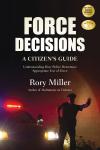Home >> Publishing >> Bundle

Rory Miller Library Bundle
by Rory Miller
Use too much force and you are going to jail. Use too little force and you’re in for a world of hurt. If you do not know how to succeed at all six levels there are situations in which you will have no appropriate options. More often than not, that will end badly.$94.75
$66.32
Book: Meditations on Violence—A Comparison of Martial Arts Training and Real World Violence by Rory Miller
A Comparison of Martial Arts Training & Real-World Violence.
Experienced martial artist and veteran correction officer Sgt. Rory Miller distills what he has learned from jailhouse brawls, tactical operations and ambushes to explore the differences between martial arts and the subject martial arts were designed to deal with: Violence.
Sgt. Miller introduces the myths, metaphors and expectations that most martial artists have about what they will ultimately learn in their dojo. This is then compared with the complexity of the reality of violence. Complexity is one of the recurring themes throughout this work.
Section Two examines how to think critically about violence, how to evaluate sources of knowledge and clearly explains the concepts of strategy and tactics.
Sections Three and Four focus on the dynamics of violence itself and the predators who perpetuate it. Drawing on hundreds of encounters and thousands of hours spent with criminals Sgt. Miller explains the types of violence; how, where, when and why it develops; the effects of adrenaline; how criminals think, and even the effects of drugs and altered states of consciousness in a fight.
Section Five centers on training for violence, and adapting your present training methods to that reality. It discusses the pros and cons of modern and ancient martial arts training and gives a unique insight into early Japanese kata as a military training method.
Section Six is all about how to make self-defense work. Miller examines how to look at defense in a broader context, and how to overcome some of your own subconscious resistance to meeting violence with violence.
The last section deals with the aftermath—the cost of surviving sudden violence or violent environments, how it can change you for good or bad. It gives advice for supervisors and even for instructors on how to help a student/survivor. You'll even learn a bit about enlightenment.
B1187
Book: Facing Violence—Preparing for the Unexpected by Rory Miller
Our very best in self-defense
Survival Favors the Prepared Mind—Robert Crowley
This book stands alone as an introduction to the context of self-defense. There are seven elements that must be addressed to bring self-defense training to something approaching ‘complete.’ Any training that dismisses any of these areas leaves you vulnerable.
- 1. Legal and ethical implications. A student learning self-defense must learn force law. Otherwise it is possible to train to go to prison. Side by side with the legal rules, every student must explore his or her own ethical limitations. Most do not really know where this ethical line lies within them.
- 2. Violence dynamics. Self-defense must teach how attacks happen. Students must be able to recognize an attack before it happens and know what kind they are facing.
- 3. Avoidance. Students need to learn and practice not fighting. Learning includes escape and evasion, verbal de-escalation, and also pure-not-be there avoidance.
- 4. Counter-ambush. If the student didn’t see the precursors or couldn’t successfully avoid the encounter he or she will need a handful of actions trained to reflex level for a sudden violent attack.
- 5. Breaking the freeze. Freezing is almost universal in a sudden attack. Students must learn to recognize a freeze and break out of one.
- 6. The fight itself. Most martial arts and self-defense instructors concentrate their time right here. What is taught just needs to be in line with how violence happens in the world.
- 7. The aftermath. There are potential legal, psychological, and medical effects of engaging in violence no matter how justified. Advanced preparation is critical.
Any teacher or student of self-defense, anyone interested in self-defense, and any person who desires a deeper understanding of violence needs to read this book.
We strongly recommend this book to anybody wishing to learn self-defense, or understand how to stay safe should violence rear it's ugly head
B2139
Book: Force Decisions—A Citizen's Guide: Understanding How Police Determine Appropriate Use of Force by Rory Miller
Cooperation, Compliance, Control.
In a free and peaceful society where so many have been taught that all violence is wrong, citizens are often confused and dismayed when officers use force, even when the force is perfectly lawful and justified.
This book allows you to 'take' a basic USE OF FORCE class just as if you were a rookie at the police academy. Below are some highlights of what is included in 'your' basic use of force class:
SECTION 1. TRAINING. I explain policy and laws that officers are taught. We examine use of force, how to define a threat, and the difference between excessive force and unnecessary force.
SECTION 2. CHECKS AND BALANCES. This section explains how an officer's decisions are examined if suspected of being bad decisions.
SECTION 3. EXPERIENCE. We explore how officers see the world that they live in. Somewhere in the fog between training and experience, the officer has to make a decision. Sometimes decisions will be made in a fraction of a second and on partial information. Sometimes a decision will change the lives of everyone involved—forever.
SECTION 4. ABOUT YOU. Review what you should have learned. Why does community action fail? What is it that can really be done? Know how to behave when faced by an officer. Until this section, I have tried to put you in the headspace of an officer, giving you an overview of his training and a taste of his experiences. Now I will try to let you feel like a suspect. That's a lot of mind bending for one book. Get plenty of sleep and drink lots of water.
Any civilian, law enforcement officer or martial artist interested in self-defense, or anyone wanting to understand the duties and responsibilities of civilians and police officers needs to read this book.
B2436
Book: Scaling Force—Dynamic Decision Making Under Threat of Violence by Rory Miller
Use too much force and you are going to jail.
Use too little force and you're in for a world of hurt.
Conflict and violence cover a broad range of behaviors, from intimidation to murder, and they require an equally broad range of responses. A kind word will not resolve all situations, nor will wristlocks, punches or even a gun.
In Scaling Force the authors introduce you to the full range of options, from skillfully doing nothing to applying deadly force. They realistically guide you through understanding the limits of each type of force, when specific levels may be appropriate, the circumstances under which you may have to apply them, and the potential cost, legally and personally, of your decision.
- Level 1— Presence. Staving off violence using body language alone.
- Level 2 – Voice. Verbally de-escalating conflict before physical methods become necessary.
- Level 3 – Touch. Defusing an impending threat or gaining compliance via touch.
- Level 4 – Empty-Hand Restraint. Controlling a threat through pain or forcing compliance through leverage.
- Level 5 – Less-Lethal Force. Incapacitating a threat while minimizing the likelihood of fatality or permanent injury.
- Level 6 – Lethal Force. Stopping a threat with techniques or implements likely to cause death or grievous bodily harm.
It is vital to enter this scale at the right level, and to articulate why what you did was appropriate. If you do not know how to succeed at all six levels there are situations in which you will have no appropriate options. More often than not, that will end badly.
B2504
Conflict Communication—A New Paradigm in Conscious Communication
Conflict happens everywhere: at work, with friends and family, among strangers, and certainly in violence. Why did your boss ignore a suggestion that could save millions of dollars? Why do you have the same argument again and again with your spouse? When someone insults you, why do you get angry? Why do bad guys beat up the weak?
You have three brains.
- Lizard brain (survival)
- Monkey brain (emotion / social status)
- Human brain (reason)
Each “brain” has a different priority and evolved to deal with different kinds of conflict. They work using different scripts and have a very clear seniority system.
Conflict Communication(ConCom) presents a functional taxonomy to see, understand, and manipulate the roots of
life’s conflicts. You will have the background, the principles,
and a collection of tricks to manage and ideally avoid
dangerous conflicts.
No going back. After reading this book, you can never go back. Even if you reject everything in the program, even if you refuse to admit how often your monkey brain has controlled your life, escalations toward conflict will never again be invisible to you.
As the fortune cookie says, “Your life is about to change.”
B3310
No content.
No content.
About the Author





